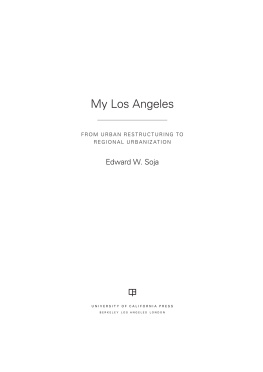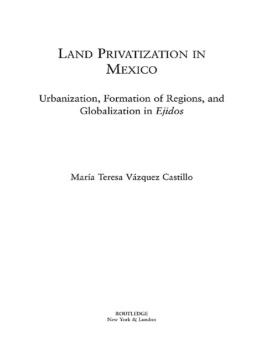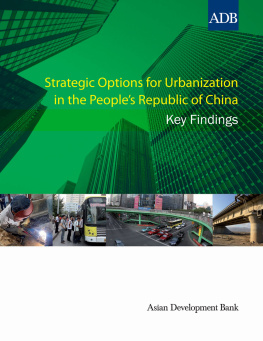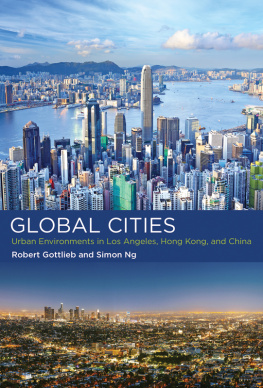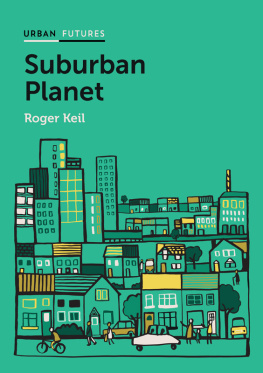ACKNOWLEDGMENTS
My first expression of thanks goes to Stefano Bloch, without whose assistance chapter 9 could not have been written. Stefano is the source for figures 8 to 12, three of which are painted by the mural artist Mear One and are included with his permission. Special thanks also to Eugene Turner and James Allen, Department of Geography, California State UniversityNorthridge, for preparing on short notice maps 1 to 4. Photo-artist Antonis Ricos, my close friend, helped prepare figures 2 to 6 and map 12, which were published originally in Thirdspace: Journeys to Los Angeles and Other Real-and-Imagined Places (Blackwell Publishers, 1996). Coordinating the illustrative material, preparing it all for publication, and redrawing figure 7 entirely was Sean Combs, not the rap star but my son-in-law and father of the exceedingly delightful Addison. Thanks, Sean.
Chapters 1 to 8 draw to different degrees on my previously published work. All the major sources are identified for each chapter in appendix 1. Worth mentioning in particular are maps 5 to 11, which are reproduced from Postmodern Geographies: The Reassertion of Space in Critical Social Theory, published by Verso Press in 1989 and republished in their Radical Thinkers series in 2011. Sections of chapter 3 are taken directly from Inside Exopolis: Everyday Life in the Postmodern World, chapter 8 in Thirdspace. I would also like to thank University of Minnesota Press for adaptations from Seeking Spatial Justice (2010) in chapter 8, and University of California Press for the use of map 13 from the introduction to The City, coauthored by Allen Scott and Edward W. Soja. Thanks must go to my coauthors: Goetz Wolff, Rebecca Morales, Allen Scott, and Juan Miguel Kanai.
I completed the first draft of this book while taking advantage of the excellent facilities of the Canadian Centre for Architecture in Montreal as a Mellon Senior Research Fellow from July 2 to August 10, 2012. My thanks to the Mellon Foundation, and to Phyllis Lambert (Founding Director) and Mirko Zardini (Director and Chief Curator) of the CCA. Helpful from the start and throughout my stay in Montreal was Alexis Sornin, Head of the Study Centre. Thanks also to Catherine Bella, who served as my research assistant. Learning about local and regional politics in Montreal added significantly to the last three chapters.
Introduction
With its incomparable outward reach, Los Angeles vividly screens itself everywhere on earth, evoking imagesand strong opinionsfrom practically everyone, including many who have never been there and depend on the opinions and images of others to shape their impressions. Its iconic imagery provokes exaggeration, fomenting emotionally excessive repulsion as well as unbridled attraction. Real and imagined LA seethes with such paradoxesprovocative intertwinings of utopia and dystopia, brilliant sunshine and noir decadence, opportunity and danger, optimism and despair.
Further complicating any understanding of the actual place, Los Angeles for the past century has been a fountainhead of imaginative fantasy, emitting a mesmerizing force that obscures reality by eroding the difference between the real and the imagined, fact and fiction. As one observer put it, Los Angeles has a history of forgetting,
LAs first major surge of urban development in the late nineteenth century was rooted in creative simulations of an Edenic Los Angeles, from the ersatz romanticism of the Ramona myth, which preached peaceful interracial love in an earthly paradise, the war, take the gold of Northern California while bleaching LA non-Hispanic white.
More global in its impact was Hollywood, Americas fulsome dream machine, pouring out realistic fakes that entertained nearly everyone on earth. Virtually synonymous with Los Angeles for most of the world, Hollywood became the fountainhead for an epidemic spread of what the cultural critic Jean Baudrillard called hyperreality, confusing our ability to tell the difference between the real and the imagined, fact and fiction. Baudrillard blithely proclaims that when hyperreality, Hollywood generated or otherwise, takes hold of individual and collective behavior, the map precedes the territory: the real material world (and with it actually existing Los Angeles) seems to melt into its never completely accurate representations, intopardon the clichthe reel world.
Blossoming from all these increasingly influential simulations of reality, of course, was Disneyland, established in Orange County in 1956 and mapped out by its professional imagineers into its representative continental zones: Tomorrowland, Adventureland, Frontierland, and Fantasyland, all entered through a shrunken version of Main Street USA, the better to fool you into thinking it is all really real. Hyperreality, however, was not confined by the boundaries of the theme park. Spreading out from Disneyland and covering adjacent Orange and Los Angeles counties was a thick blanket of deception that has made it increasingly difficult for everyone involved to tell the difference between what is real and what is purely (or impurely) imagined. The diffusion of this interstitial hyperreality, in between fact and fiction, produced what I describe in chapter 3 as a scamscape, a constructed geography filled with trickery, misrepresentation, and often innovative forms of fraud, perpetrated, like the savings and loan fiasco of the early 1990s, by people who genuinely believed that what they were doing was not only acceptable but virtuous.

